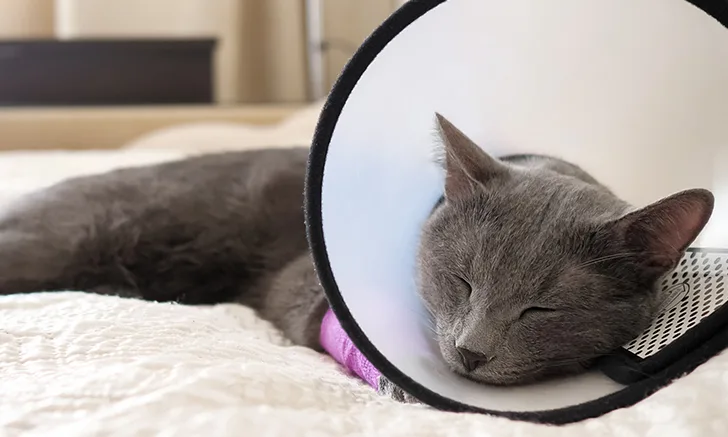Protecting Patients with a Multimodal Approach to Preanesthesia

Sponsored by Zoetis
The goals of preanesthesia are to reduce patient anxiety and stress, provide pre-emptive analgesia and muscle relaxation, and lower the amount of induction drugs and inhalant gas needed.1,2 Effective preanesthesia leads to a decreased risk for dose-dependent adverse effects, a smoother induction that is likely to result in a smoother anesthesia recovery, and less pain on recovery.1,2 A smooth, uneventful anesthetic event, as a result of good preanesthesia, can lead to decreased stress and increased overall job satisfaction for the veterinary team.
Case 1: Maisie
Maisie, a 6-month-old female domestic medium-hair cat, was presented for ovariohysterectomy, with no concerns on physical examination or blood work (American Society of Anesthesia Physical Status classification I).
Simbadol™ (buprenorphine, 1.8 mg/mL [0.24 mg/kg SC]) was given on admission, and Dexdomitor (dexmedetomidine [0.01 mg/kg IM]) and Torbugesic-SA (butorphanol [0.4 mg/kg IM]) were administered 30 minutes later. Sedation occurred within 20 minutes, and an IV catheter was placed and alfaxalone administered over 60 to 90 seconds IV to effect.
Maisie was intubated and maintained on isoflurane/oxygen, and Lactated Ringer solution (3 mL/kg/hr IV) was administered. Heart and respiratory rates, temperature, blood pressure, oxygen saturation, and end-tidal CO2 were measured every 5 minutes, and ECG was monitored throughout.
A smooth, uneventful anesthetic event, as a result of good preanesthesia, can lead to decreased stress and increased overall job satisfaction for the veterinary team.
The procedure was uneventful; the abdomen was lavaged with bupivacaine (1 mg/kg diluted in 2 mL of sterile saline), and a small amount of this solution was used for a linea splash block prior to closure. Robenacoxib (2 mg/kg) was given SC, then orally (6-mg tablets) 24 hours and 48 hours postoperation, and she was comfortable postoperation.
Simbadol is a partial µ agonist that provides a moderate degree of analgesia.3,4 Adverse effects such as nausea are uncommon; however, cats may exhibit elevated temperatures, and euphoric/dysphoric behavior has been reported.3-5
Simbadol can be safely used with other analgesics to provide multimodal analgesia.1,3,4 It should be given 1 hour prior to surgery and can therefore be given prior to IM or IV premedications or along with butorphanol,3 which has a very rapid yet short duration of action and a lower affinity for opioid receptors than Simbadol.6,7
Case 2: Reese
Reese, a 7-year-old neutered male domestic shorthair cat, was presented for a dental examination to address resorptive lesions on 204 and 207. No abnormalities were noted on preanesthetic blood work.
Reese had a grade III/VI holosystolic murmur and had been diagnosed 2 weeks prior with mild hypertrophic cardiomyopathy (HCM) with left ventricular outflow obstruction (LVOT) on echocardiogram.
Simbadol was administered upon admission, and Dexdomitor and Torbugesic-SA were administered prior to induction. Sedation occurred within 20 minutes, and an IV catheter was placed and alfaxalone administered over 60 to 90 seconds IV to effect. Reese was intubated and maintained on isoflurane/oxygen, and Lactated Ringer solution (3 mL/kg/hr IV) was administered. Heart and respiratory rates, temperature, blood pressure, oxygen saturation, and end-tidal CO2 were measured every 5 minutes, and ECG was monitored throughout the procedure.
Full-mouth radiography was performed, as well as a full oral examination, scaling, and polishing. After a left caudal infraorbital nerve block was performed using 0.2-mL bupivacaine (0.5%), 204 and 207 were extracted. Robenacoxib (2 mg/kg) was given SC, then orally (6-mg tablets) 24 and 48 hours postoperation. Reese's owner reported that he was comfortable on follow-up call 3 days later.
Conclusion
Both Maisie and Reese benefited from balanced multimodal anesthesia that allowed their procedures to be performed safely and their recovery to be smooth and comfortable. Dexdomitor provided sedation and analgesia and decreased the amount of induction and maintenance agents. Torbugesic-SA provided sedation and mild analgesia, with Simbadol and robenacoxib providing analgesia.
The same preanesthetic protocol was used in both cases despite Reese’s older age and underlying HCM. Despite some clinicians’ reluctance to use α2 agonists in cats with HCM, a recent study demonstrated that LVOT was actually eliminated on echocardiography in cats with HCM and dynamic LVOT while patients were sedated with medetomidine.8 Because dexmedetomidine is the active molecule in medetomidine, similar results should be expected.9
By using a combination of effective sedatives, appropriate intraoperative monitoring, and long-acting, effective pain control, veterinary teams can feel confident that they are minimizing the chance of adverse events and providing a safe and comfortable anesthesia experience for their patients.
DEXDOMITOR IMPORTANT SAFETY INFORMATION
Do not use DEXDOMITOR in dogs or cats with cardiovascular disease, respiratory disorders, liver or kidney diseases, or in conditions of shock, severe debilitation, or stress due to extreme heat, cold or fatigue. DEXDOMITOR should not be administered in the presence of preexisting hypotension, hypoxia, or bradycardia. As with all α2-adrenoceptor agonists, the potential for isolated cases of hypersensitivity, including paradoxical response (excitation), exists with DEXDOMITOR. The use of DEXDOMITOR as a preanesthetic in dogs and cats significantly reduces the amount of induction and maintenance anesthetic requirements. Careful patient monitoring is necessary to avoid anesthetic overdose. Arrhythmias, bradycardia, apnea, emesis, convulsions, hypersalivation may occur with DEXDOMITOR use. Severe dyspnea and respiratory crackles due to acute or delayed pulmonary edema could develop in cats. DEXDOMITOR has not been evaluated for use in breeding, pregnant, or lactating dogs or cats; in dogs younger than 16 weeks of age or in cats younger than 12 weeks of age; or in geriatric dogs or cats. See full Prescribing Information at Dexdomitor/PI.com
SIMBADOL IMPORTANT SAFETY INFORMATION
Due to serious human safety and abuse concerns, including physical or psychological dependence, life-threatening respiratory depression and additive CNS depressant effects, read the full prescribing information before using this drug, including the complete Boxed Warning. Not for use in humans. Hospital staff should be trained in the handling of potent opioids and should avoid accidental exposure. SIMBADOL has not been evaluated in breeding, pregnant, or lactating cats, in cats younger than 4 months of age or moribund cats. Do not use in cats with known hypersensitivity to buprenorphine hydrochloride or any of the components of SIMBADOL, or known intolerance to opioids. Use with caution in cats with impaired hepatic function. Adverse reactions may include hyperthermia, tachycardia, hypotension, hypertension, hypothermia, anorexia, and hyperactivity. For more safety information, refer to the full Prescribing Information at Simbadol/PI.com
TORBUGESIC-SA IMPORTANT SAFETY INFORMATION
Use TORBUGESIC-SA in cats only. Not recommended for use in pregnant cats, breeding male cats, and in kittens less than 4 months old. Use with caution with other sedative or analgesic drugs as these are likely to produce additive effects. Adverse reactions may include pain on injection, mydriasis, disorientation, swallowing, licking, and sedation. See full Prescribing Information at TorbugesicSA/PI.com
